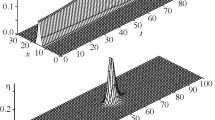Abstract
A condition for the emergence of a discontinuity in an elastic peridynamic body is proposed, resulting in a material stability condition for crack nucleation. The condition is derived by determining whether a small discontinuity in displacement, superposed on a possibly large deformation, grows over time. Stability is shown to be determined by the sign of the eigenvalues of a tensor field that depends only on the linearized material properties. This condition for nucleation of a discontinuity in displacement can be interpreted in terms of the dynamic stability of plane waves with very short wavelength. A numerical example illustrates that cracks in a peridynamic body form spontaneously as the body is loaded.
Similar content being viewed by others
References
Agwai A, Guven I, Madenci E (2008) Peridynamic theory for failure prediction in multilayer thin-film structures of electronic packages. In: 2008 electronic components and technology conference. IEEE, pp 1614–1619
Agwai A, Guven I, Madenci E (2008) Peridynamic theory for impact damage prediction in electronic packages due to drop. In: 2008 electronic components and technology conference. IEEE, pp 1048–1053
Agwai A, Guven I, Madenci E (2009) Damage prediction for electronic package drop test using finite element and peridynamic theory. In: 2008 electronic components and technology conference. IEEE, pp 565–569
Askari E, Xu J, Silling S (2006) Peridynamic analysis of damage and failure in composites. In: 44th AIAA aerospace sciences meeting and exhibit, Reno, NV, AIAA2006-88
Bazant ZP, Belytschko T (1985) Wave propagation in a strain-softening bar: exact solution. J Eng Mech (ASCE) 111: 381–389
Belytschko T, Chen H, Xu J, Zi G (2003) Dynamic crack propagation based on loss of hyperbolicity and a new discontinuous enrichment. Int J Numer Methods Eng 58: 1873–1905
Bobaru F (2007) Influence of van der Waals forces on increasing the strength and toughness in dynamic fracture of nanofibre networks: a peridynamic approach. Model Simul Mater Sci Eng 15: 397–417
Colavito KW, Kilic B, Celik E, Madenci E, Askari E, Silling S (2007) Effect of void content on stiffness and strength of composites by a peridynamic analysis and static indentation test. In: 48th AIAA/ASME/ASCE/AHS/ASC structures, structural dynamics, and materials conference, Honolulu, HI, AIAA2007-2251
Dayal K, Bhattacharya K (2006) Kinetics of phase transformations in the peridynamic formulation of continuum mechanics. J Mech Phys Solids 54: 1811–1842
Gerstle W, Sau N, Silling S (2007) Peridynamic modeling of concrete structures. Nucl Eng Des 237: 1250–1258
Hill R (1962) Acceleration waves in solids. J Mech Phys Solids 10: 1–16
Kilic B, Madenci E (2009) Prediction of crack paths in a quenched glass plate by using peridynamic theory. Int J Fract 156: 165–177
Kilic B, Agwai A, Madenci E (2009) Peridynamic theory for progressive damage prediction in center-cracked composite laminates. Compos Struct 90: 141–151
Klein P, Gao H (1998) Crack nucleation and growth as strain localization in a virtual-bond continuum. Eng Fract Mech 61: 21–48
Knowles JK, Sternberg E (1975) On the ellipticity of the equations of nonlinear elastostatics for a special material. J Elast 5: 341–361
Knowles JK, Sternberg E (1978) On the failure of ellipticity and the emergence of discontinuous deformation gradients in plane finite elastostatics. J Elast 8: 329–379
Kunin IA (1983) Elastic media with microstructure II: three-dimensional models. Springer, Berlin
Leroy Y, Ortiz M (1989) Finite element analysis of strain localization in frictional materials. Int J Numer Anal Methods Geomech 13: 53–74
Rudnicki JW, Rice JR (1975) Conditions for the localization of deformation in pressure-sensitive dilatant materials. J Mech Phys Solids 23: 371–394
Silling SA (2000) Reformulation of elasticity theory for discontinuities and long-range forces. J Mech Phys Solids 48: 175–209
Silling SA (2003) Dynamic fracture modeling with a meshfree peridynamic code. In: Bathe KJ (eds) Computational fluid and solid mechanics. Elsevier, Amsterdam, pp 641–644
Silling SA, Askari E (2005) A meshfree method based on the peridynamic model of solid mechanics. Comput Struct 83: 1526–1535
Silling SA, Bobaru F (2005) Peridynamic modeling of membranes and fibers. Int J Non-Linear Mech 40: 395–409
Silling SA, Epton M, Weckner O, Xu J, Askari E (2007) Peridynamic states and constitutive modeling. J Elast 88: 151–184
Silling SA (2010) Linearized theory of peridynamic states. J. Elast. doi:10.1007/s10659-009-9234-0
Xu J, Askari A, Weckner O, Razi H, Silling S (2007) Damage and failure analysis of composite laminates under biaxial loads. In: 48th AIAA/ASME/ASCE/AHS/ASC structures, structural dynamics, and materials conference, Honolulu, HI, AIAA2007-2315
Xu J, Askari A, Weckner O, Silling S (2008) Peridynamic analysis of impact damage in composite laminates. J Aerosp Eng 21: 187–194
Weckner O, Abeyaratne R (2005) The effect of long-range forces on the dynamics of a bar. J Mech Phys Solids 53: 705–728
Author information
Authors and Affiliations
Corresponding author
Rights and permissions
About this article
Cite this article
Silling, S.A., Weckner, O., Askari, E. et al. Crack nucleation in a peridynamic solid. Int J Fract 162, 219–227 (2010). https://doi.org/10.1007/s10704-010-9447-z
Received:
Accepted:
Published:
Issue Date:
DOI: https://doi.org/10.1007/s10704-010-9447-z




